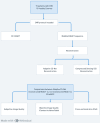Accelerated Non-Contrast-Enhanced Three-Dimensional Cardiovascular Magnetic Resonance Deep Learning Reconstruction
- PMID: 40776949
- PMCID: PMC12326416
- DOI: 10.31083/RCM37399
Accelerated Non-Contrast-Enhanced Three-Dimensional Cardiovascular Magnetic Resonance Deep Learning Reconstruction
Abstract
Background: Cardiovascular magnetic resonance (CMR) is a time-consuming, yet critical imaging method. In contrast, while rapid techniques accelerate image acquisition, these methods can also compromise image quality. Meanwhile, the effectiveness of Adaptive CS-Net, a vendor-supported deep-learning magnetic resonance (MR) reconstruction algorithm, for non-contrast three-dimensional (3D) whole-heart imaging using relaxation-enhanced angiography without contrast and triggering (REACT) remains uncertain.
Methods: Thirty participants were prospectively recruited for this study. Each underwent non-contrast imaging that included a modified REACT sequence and a standard 3D balanced steady-state free precession (bSSFP) sequence. The REACT data were acquired through six-fold undersampling and reconstructed offline using both conventional compressed sensing (CS) and an Adaptive CS-Net algorithm. Subjective and objective image quality assessments, as well as cross-sectional area measurements of selected vessels, were conducted to compare the REACT images reconstructed using Adaptive CS-Net against those reconstructed using conventional CS, as well as the standard bSSFP sequence. For a statistical comparison of image quality across these three image sets, the nonparametric Friedman test was performed, followed by Dunn's post-hoc test.
Results: The Adaptive CS-Net and CS-reconstructed REACT images exhibited superior image quality for pulmonary veins, neck, and upper thoracic vessels compared to the standard 3D bSSFP sequence. Adaptive CS-Net and CS reconstructed REACT images displayed significantly higher contrast-to-noise ratio (CNR) compared to those reconstructed using the 3D bSSFP sequence (all p-values < 0.05) for the left upper (5.40, 5.53, 0.97), left lower (6.33, 5.84, 2.27), right upper (5.49, 6.74, 1.18), and right lower pulmonary veins (6.71, 6.41, 1.26). Additionally, REACT methods showed a statistically significant improvement in CNR for both the ascending aorta and superior vena cava compared to the 3D bSSFP sequence.
Conclusions: The Adaptive CS-Net reconstruction for the REACT images consistently delivered superior or comparable image quality compared to the CS technique. Notably, the Adaptive CS-Net reconstruction provides significantly enhanced image quality for pulmonary veins, neck, and upper thoracic vessels compared to 3D bSSFP.
Keywords: Adaptive CS-Net; artificial intelligence; cardiovascular magnetic resonance; congenital heart disease; deep learning.
Copyright: © 2025 The Author(s). Published by IMR Press.
Conflict of interest statement
The authors declare no conflict of interest.
Figures






Similar articles
-
Qualitative and quantitative analysis of functional cardiac MRI using a novel compressed SENSE sequence with artificial intelligence image reconstruction.Magn Reson Imaging. 2025 Oct;122:110448. doi: 10.1016/j.mri.2025.110448. Epub 2025 Jun 19. Magn Reson Imaging. 2025. PMID: 40543831
-
Feasibility of magnetization-transfer-contrast relaxation-enhanced angiography without contrast and triggering (REACT) imaging at 1.5 T combined with deep learning-based reconstruction for cardiovascular visualization.Quant Imaging Med Surg. 2025 Apr 1;15(4):3222-3236. doi: 10.21037/qims-24-2199. Epub 2025 Mar 28. Quant Imaging Med Surg. 2025. PMID: 40235803 Free PMC article.
-
Equilibrium phase contrast-enhanced magnetic resonance angiography of the thoracic aorta and heart using balanced T1 relaxation-enhanced steady-state.J Cardiovasc Magn Reson. 2024 Winter;26(2):101046. doi: 10.1016/j.jocmr.2024.101046. Epub 2024 May 27. J Cardiovasc Magn Reson. 2024. PMID: 38810732 Free PMC article.
-
Magnetic resonance perfusion for differentiating low-grade from high-grade gliomas at first presentation.Cochrane Database Syst Rev. 2018 Jan 22;1(1):CD011551. doi: 10.1002/14651858.CD011551.pub2. Cochrane Database Syst Rev. 2018. PMID: 29357120 Free PMC article.
-
Artificial intelligence for diagnosing exudative age-related macular degeneration.Cochrane Database Syst Rev. 2024 Oct 17;10(10):CD015522. doi: 10.1002/14651858.CD015522.pub2. Cochrane Database Syst Rev. 2024. PMID: 39417312
References
-
- Krishnam MS, Tomasian A, Deshpande V, Tran L, Laub G, Finn JP, et al. Noncontrast 3D steady-state free-precession magnetic resonance angiography of the whole chest using nonselective radiofrequency excitation over a large field of view: comparison with single-phase 3D contrast-enhanced magnetic resonance angiography. Investigative Radiology . 2008;43:411–420. doi: 10.1097/RLI.0b013e3181690179. - DOI - PubMed
LinkOut - more resources
Full Text Sources

